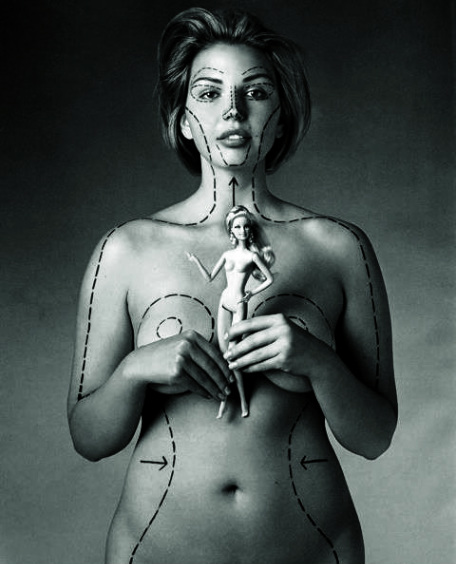social influences: media
_ _ _ _ _ _ _ _ _ _ _ _ _ _ _ _ _ _ _ _ _ _ _ _ _ _ _ _ _ _ _ _ _ _ _ _ _ _ _ _ _ _ _ _ _ _ _ _ _
|
Although a child’s body image is affected by many things, media is particularly powerful. The term media refers to widely transmitted or mass produced materials that primarily exist for the purpose of entertainment or advertising. The material may exist as print-based materials (e.g., magazines) or electronic (e.g., radio, music videos, TV shows, movies, internet).
As you may be aware, media often conveys unrealistic and unachievable messages about appearance, body size, and shape ideals, which are linked to the idea that having a particular body will be rewarding (e.g., lead to happiness). An example of a media message for young children is how characters in stories, games, TV shows, and movies are portrayed. The heroes (e.g., Batman) are often good-looking, slim but with muscles, while the heroines (e.g., Cinderella) are often pretty and thin. Evidently, for boys, media often promotes the ‘muscular ideal’, whereas for girls, media often promotes the ‘thin ideal’. Media also sends an inaccurate but powerful message that it’s possible and easy to change our bodies in any way we want to. As adults we may have, at some time, taken on board messages from the media about the ‘ideal’ body and judged ourselves according to these messages. In a similar way, children are especially vulnerable and need some guidance as to how to deal with such messages. |
If children view and believe media that promotes thinness, or muscularity, as the way to happiness and success, this can lead to greater body dissatisfaction and unhealthy eating behaviours. Media messages that larger body sizes are unattractive, can also be harmful. As a child becomes an adolescent media messages can reinforce the importance of having an ‘ideal’ body. So, getting in early to help your child learn how to deal with these messages is an important goal.
_ _ _ _ _ _ _ _ _ _ _ _ _ _ _ _ _ _ _ _ _ _ _ _ _ _ _ _ _ _ _ _ _ _ _ _ _ _ _ _ _ _ _ _ _ _ _ _
Tips for dealing with media
_ _ _ _ _ _ _ _ _ _ _ _ _ _ _ _ _ _ _ _ _ _ _ _ _ _ _ _ _ _ _ _ _ _ _ _ _ _ _ _ _ _ _ _ _ _ _ _
• Aim to promote your child’s resilience to media messages from early childhood, to minimise how influential and powerful the
media may be as your child gets older.
• Be a good role model by not endorsing, but instead being critical of, media that promotes unachievable and unrealistic
appearance and body ideals.
• Encourage your child to look at age-appropriate media. Think about what type of ‘messages’ are being conveyed. Are they
healthy weight and shape messages? Or are they focused on looking a particular way or ‘fitting in’?
See Fact Sheet 3
• Within your home, limit screen time and exposure to magazines that promote the values and ideals of beauty and thinness for
girls and muscularity for boys (e.g., fashion magazines, weight-loss TV shows).
• Help your child understand that the way people look in the media is not how most people in real life look.
• Talk about qualities aside from appearance and discuss why the achievements of some public figures or characters make them
good role models or people (e.g., Superman is special because he helps people, rather than Superman is special because he is
strong and has big muscles).
• Be aware of, or monitor, what your child is watching. If they are using the internet, make sure they are accessing
appropriate material.
• Talk to children about how images in magazines and advertising can be changed and altered on the computer.
media may be as your child gets older.
• Be a good role model by not endorsing, but instead being critical of, media that promotes unachievable and unrealistic
appearance and body ideals.
• Encourage your child to look at age-appropriate media. Think about what type of ‘messages’ are being conveyed. Are they
healthy weight and shape messages? Or are they focused on looking a particular way or ‘fitting in’?
See Fact Sheet 3
• Within your home, limit screen time and exposure to magazines that promote the values and ideals of beauty and thinness for
girls and muscularity for boys (e.g., fashion magazines, weight-loss TV shows).
• Help your child understand that the way people look in the media is not how most people in real life look.
• Talk about qualities aside from appearance and discuss why the achievements of some public figures or characters make them
good role models or people (e.g., Superman is special because he helps people, rather than Superman is special because he is
strong and has big muscles).
• Be aware of, or monitor, what your child is watching. If they are using the internet, make sure they are accessing
appropriate material.
• Talk to children about how images in magazines and advertising can be changed and altered on the computer.
videos 2 & 3:
More on the media messages your child may be exposed to and how you can learn to be critical of the media.
|
|
|




